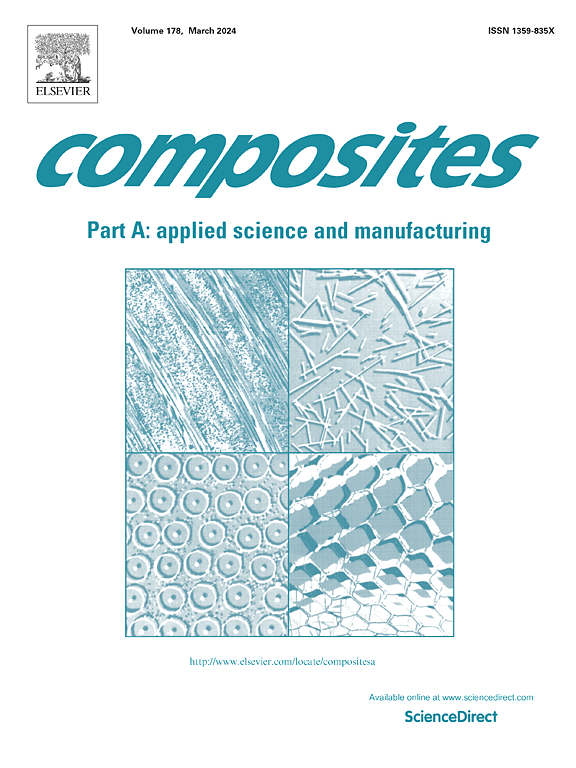Superior compressive performance of a novel plate-added X-lattice core sandwich structure at elevated temperatures
IF 8.1
2区 材料科学
Q1 ENGINEERING, MANUFACTURING
Composites Part A: Applied Science and Manufacturing
Pub Date : 2025-05-04
DOI:10.1016/j.compositesa.2025.108992
引用次数: 0
Abstract
Due to its orthotropic and three-dimensionally open-pored characteristic, the lattice sandwich structure having double-functionally load support and thermal management is considered one of the most typical and promising structures. However, a single core topology that concurrently excels in both mechanical and thermal performance remains a significant challenge. To address this issue, this paper employs a hybrid concept to design a novel plate-added X-lattice core sandwich structure (PX) with concurrent thermal and mechanical load-bearing capabilities. The compressive properties of PX, fabricated by Selective Laser Melting (SLM) technique, are comprehensively investigated by combining experimental, theoretical, and numerical methods at 25∼800 °C.The results indicate that the compressive strength of PX decreases by approximately 41.6 % as the temperature increases from 25 °C to 800 °C. During the compression process, there exists a mutual restraint effect between the struts of the X-lattice and the plate. Due to the limited plasticity of the printed Ni718 alloy, after yielding, the specimens exhibit catastrophic failure, leading to suboptimal energy absorption performance at varied temperatures. Additionally, systematic parameter studies quantitatively demonstrate the influence of specific parameters on the specified strength of the proposed structure. Compared with competing cellular materials, PX demonstrates superiority in specific strength on the material selection map.
一种新型加板x晶格芯夹层结构在高温下的优越压缩性能
具有载荷支撑和热管理双重功能的晶格夹层结构由于其正交异性和三维开孔的特性,被认为是最典型和最有前途的结构之一。然而,单核拓扑结构在机械和热性能上同时表现优异仍然是一个重大挑战。为了解决这一问题,本文采用混合概念设计了一种具有热、机械双重承载能力的新型加板x晶格核心夹层结构(PX)。采用选择性激光熔化(SLM)技术制备的PX在25 ~ 800°C下的压缩性能,通过实验、理论和数值方法进行了全面研究。结果表明:当温度从25℃升高到800℃时,PX的抗压强度降低约41.6%;在压缩过程中,x -晶格的支板与板之间存在相互约束作用。由于Ni718合金的塑性有限,在屈服后,试样会出现灾难性的破坏,导致在不同温度下的能量吸收性能不理想。此外,系统的参数研究定量地证明了特定参数对所提出结构的指定强度的影响。与竞争的细胞材料相比,在材料选择图上,PX在比强度上表现出优势。
本文章由计算机程序翻译,如有差异,请以英文原文为准。
求助全文
约1分钟内获得全文
求助全文
来源期刊

Composites Part A: Applied Science and Manufacturing
工程技术-材料科学:复合
CiteScore
15.20
自引率
5.70%
发文量
492
审稿时长
30 days
期刊介绍:
Composites Part A: Applied Science and Manufacturing is a comprehensive journal that publishes original research papers, review articles, case studies, short communications, and letters covering various aspects of composite materials science and technology. This includes fibrous and particulate reinforcements in polymeric, metallic, and ceramic matrices, as well as 'natural' composites like wood and biological materials. The journal addresses topics such as properties, design, and manufacture of reinforcing fibers and particles, novel architectures and concepts, multifunctional composites, advancements in fabrication and processing, manufacturing science, process modeling, experimental mechanics, microstructural characterization, interfaces, prediction and measurement of mechanical, physical, and chemical behavior, and performance in service. Additionally, articles on economic and commercial aspects, design, and case studies are welcomed. All submissions undergo rigorous peer review to ensure they contribute significantly and innovatively, maintaining high standards for content and presentation. The editorial team aims to expedite the review process for prompt publication.
 求助内容:
求助内容: 应助结果提醒方式:
应助结果提醒方式:


